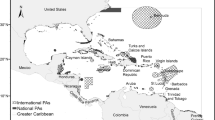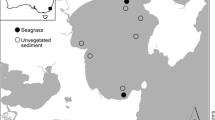Abstract
Alternatives to species-level identification have been advocated as one solution to the problem of selecting marine reserves with limited information on the distribution of marine biodiversity.This study evaluated the effects on selection of candidate sites for marine reserves from using the higher-taxon approach as a surrogate for species-level identification of intertidal molluscs and rocky reef fishes. These effects were evaluated by determining the percentage of species included in candidate reserves identified from genus-, family- and order-level data by a complementarity-based reserve selection algorithm, and by testing for correlations between the irreplaceability values of locations. Candidate reserves identified from genus- and family-level data of intertidal molluscs included a similar percentage of all species as the reserves identified from species-level data. Candidate reserves selected from genus- and family-level data of rocky reef fishes included, respectively, 3–7% and 14–23% fewer species than reserves selected from species-level data. When the reserve identification process was constrained by a practical planning limit (a maximum of 20% locations able to be reserved) the reserves selected from genus- and family-level data of intertidal molluscs, and genus-level data of rocky reef fishes, included a similar percentage of species as the reserves identified from species-level data. Irreplaceability values of locations for species, genera and families of intertidal molluscs were highly correlated, and irreplaceability values of locations for species and genera of rocky reef fishes were highly correlated. This study suggests that genus- and family-level data for intertidal molluscs, and genus-level data for rocky reef fishes, are suitable surrogates for species in the identification of candidate sites for marine reserves.
Similar content being viewed by others
References
ANZECC (Australian and New Zealand Environment Conservation Council). 1999. Strategic Plan of Action for the National Representative System of Marine Protected Areas: A Guide for Action by Australian Governments. Environment AustraliaCanberra.
A. Balmford M.J.B. Green M.G. Murray (1996a) ArticleTitleUsing higher-taxon richness as a surrogate for species richness: I. Regional tests Proc. R. Soc. Lond. Ser. B 263 1267–1274
A. Balmford A.H.M. Jayasuriya M.J.B. Green (1996b) ArticleTitleUsing higher-taxon richness as a surrogate for species richness: II. Local applications Proc. R. Soc. Lond. Ser. B 263 1571–1575
A. Balmford A.J.E. Lyon R.M. Lang (2000) ArticleTitleTesting the higher-taxon approach to conservation planning in a megadiverse group: the macrofungi Biol. Conserv. 93 209–217 Occurrence Handle10.1016/S0006-3207(99)00140-8
Beesley P.L., Ross G.J.B. and Wells A. (eds),, 1998. Mollusca: The Southern Synthesis. Fauna of Australia. Vol 5. CSIRO Publishing, Melbourne.
M.G. Chapman (1998) ArticleTitleRelationships between spatial patterns of benthic assemblages in a mangrove forest using different levels of taxonomic resolution Mar. Ecol. Prog. Ser. 162 71–78
B. Csuti S. Polasky P.H. Williams R.L. Pressey J.D. Camm M. Kershaw A.R. Kiester B. Downs R. Hamilton M. Huso K. Sahr (1997) ArticleTitleA comparison of reserve selection algorithms using data on terrestrial vertebrates in Oregon Biol. Conserv. 80 83–97 Occurrence Handle10.1016/S0006-3207(96)00068-7
S.P. Ferraro F.A. Cole (1990) ArticleTitleTaxonomic level and sample size sufficient for assessing pollution impacts on the Southern California Bight macrobenthos Mar. Ecol. Prog. Ser. 67 251–262
S. Ferrier R.L. Pressey T.W. Barrett (2000) ArticleTitleA new predictor of the irreplaceability of areas for achieving a conservation goal, its application to real-world planning, and a research agenda for further refinement Biol. Conserv. 93 303–325 Occurrence Handle10.1016/S0006-3207(99)00149-4
K.J. Gaston (1996) Spatial covariance in the species richness of higher taxa M.E. Hichberg J. Clobert R. Barbault (Eds) Aspects of the Genesis and Maintenance of Biological Diversity Oxford Oxford University Press 221–242
K.J. Gaston (2000) ArticleTitleBiodiversity: higher taxon richness Prog. Phys. Geogr. 24 117–127
W. Gladstone (2002) ArticleTitleThe potential value of indicator groups in the selection of marine reserves Biol. Conserv. 104 211–220 Occurrence Handle10.1016/S0006-3207(01)00167-7
W. Gladstone J. Davis (2003) ArticleTitleReduced survey intensity and its consequences for marine reserve selection Biodiv. Conserv. 12 1525–1536 Occurrence Handle10.1023/A:1023637917029
W. Gladstone F. Krupp M. Younis (2003) ArticleTitleDevelopment and management of a regional network of marine protected areas for the Red Sea and Gulf of Aden Ocean Coast. Manage. 46 741–761 Occurrence Handle10.1016/S0964-5691(03)00065-6
W. Gladstone M. Schreider (2003) ArticleTitleEffects of pruning a temperate mangrove forest on the associated assemblages of macroinvertebrates Mar.Freshwater Res. 54 683–690 Occurrence Handle10.1071/MF02083
P. Hopkinson J.M.J. Travis J. Evans R. Gregory M.G. Telfer P.H. Williams (2001) ArticleTitleFlexibility and the use of indicator taxa in the selection of sites for nature reserves Biodiv. Conserv. 10 271–285 Occurrence Handle10.1023/A:1008959829585
P.C. Howard P. Viskanic T.R.B. Davenport F.W. Kigenyi M. Baltzer C.J. Dickinson J.S. Lwanga R.A. Matthews A. Balmford (1998) ArticleTitleComplementarity and the use of indicator groups for reserve selection in Uganda Nature 394 472–475 Occurrence Handle10.1038/28843
P. Hutchings W. Ponder (2003) ArticleTitleMarine invertebrates and their conservation Mar. Poll. Bull. 46 153–154 Occurrence Handle10.1016/S0025-326X(02)00483-6
D. Jablonski K.W. Flessa (1986) ArticleTitleThe taxonomic structure of shallow-water marine faunas: implications for Phanerozoic extinctions Malacologia 27 43–66
R.J. James M.P. Lincoln Smith P.G. Fairweather (1995) ArticleTitleSieve mesh-size and taxonomic resolution needed to describe natural spatial variation in marine macrofauna Mar. Ecol. Prog. Ser. 118 187–198
E.A. Kay F.E. Wells W.F. Ponder (1998) Class Gastropoda P.L. Beesley G.J.B. Ross A. Wells (Eds) Mollusca: The Southern Synthesis Part B CSIRO Publishing Canberra 565–604
G. Kelleher C. Bleakley S. Wells (1995.) A Global Representative System of Marine Protected Areas, Vol. 1 The World Bank Washington
M. Kershaw G.M. Mace P.H. Williams (1995) ArticleTitleThreatened status, rarity, and diversity as alternative selection measures for protected areas: a test using Afrotropical antelopes Conserv. Biol. 9 324–334 Occurrence Handle10.1046/j.1523-1739.1995.9020324.x
J.B. Kirkpatrick (1983) ArticleTitleAn iterative method for establishing priorities for the selection of nature reserves: an example from Tasmania Biol. Conserv. 25 127–134 Occurrence Handle10.1016/0006-3207(83)90056-3
R.H. Kuiter (2000.) Coastal Fishes of South-Eastern Australia Gary Allen Sydney
T. Lasiak (2003) ArticleTitleInfluence of taxonomic resolution, biological attributes and data transformations on multivariate comparisons of rocky macrofaunal assemblages Mar. Ecol. Prog. Ser. 250 29–34
M.P. Lincoln Smith (1989) ArticleTitleImproving multispecies rocky reef fish censuses by counting different groups of species using different procedures Environ. Biol. Fish. 26 29–37 Occurrence Handle10.1007/BF00002473
B.F.J. Manly (1997) Randomization, Bootstrap and Monte Carlo Methods in Biology Chapman and Hall London
C.R. Margules R.L. Pressey (2000) ArticleTitleSystematic conservation planning Nature 405 243–253 Occurrence Handle10.1038/35012251 Occurrence Handle10821285
D.E. McAllister F.W. Schueler C.M. Roberts J.P. Hawkins (1994) Mapping and GIS analysis of the global distribution of coral reef fishes on an equal area grid R.I. Miller (Eds) Mapping the Diversity of Nature Chapman and Hall London 155–175
A.A. Myers (1997) ArticleTitleBiogeographic barriers and the development of marine biodiversity Estuar. Coast. Shelf Sci. 44 241–248 Occurrence Handle10.1006/ecss.1996.0216
InstitutionalAuthorNameNSWMPAMPASWG(New South Wales Marine Parks Authority Marine Protected Area Strategy Working group) (2001) Developing a Representative System of Marine Protected Areas in NSW-an Overview Marine Parks Authority Sydney
F. Olsgard T. Brattegard T. Holthe (2003) ArticleTitlePolychaetes as surrogates for marine biodiversity: lower taxonomic resolution and indicator groups Biodivers. Conserv. 12 1033–1049 Occurrence Handle10.1023/A:1022800405253
F. Olsgard P.J. Somerfield M.R. Carr (1998) ArticleTitleRelationships between taxonomic resolution, macrobenthic community patterns and disturbance Mar. Ecol. Prog. Ser. 172 25–36
E.J. Pharo A.J. Beattie R.L. Pressey (2000) ArticleTitleEffectiveness of using vascular plants to select reserves for bryophytes and lichens Biol. Conserv. 96 371–378 Occurrence Handle10.1016/S0006-3207(00)00080-X
A.J. Pik I. Oliver A.J. Beattie (1999) ArticleTitleTaxonomic sufficiency in ecological studies of terrestrial invertebrates Aust. J. Ecol. 24 555–562 Occurrence Handle10.1046/j.1442-9993.1999.01003.x
W. Ponder P. Hutchings R. Chapman (2002) Overview of the Conservation of Australian Marine Invertebrates Australian MuseumSydney and Environment Australia Canberra
R.L. Pressey (1998) Algorithms, politics and timber: an example of the role of science in a public, political negotiation process over new conservation areas in production forests R. Wills R. Hobbs (Eds) Ecology for Everyone: Communicating Ecology to Scientists, the Public and the Politicians Surrey Beatty and Sons Sydney 73–87
R.L. Pressey (1999) ArticleTitleApplications of irreplaceability analysis to planning and management problems Parks 9 42–51
R.L. Pressey I.R. Johnson P.D. Wilson (1994) ArticleTitleShades of irreplaceability: towards a measure of the contribution of sites to a reservation goal Biodiv. Conserv. 3 242–262 Occurrence Handle10.1007/BF00055941
R.L. Pressey K.H. Taffs (2001) ArticleTitleScheduling conservation action in production landscapes: priority areas in western New South Wales defined by irreplaceability and vulnerability to vegetation loss Biol. Conserv. 100 355–376 Occurrence Handle10.1016/S0006-3207(01)00039-8
A.G. Rebelo W.R. Siegfried (1992) ArticleTitleWhere should nature reserves be located in the Cape Floristic Region, South Africa? – models for the spatial configuration of a reserve network aimed at maximising the protection of floral diversity. Conserv. Biol. 6 243–252 Occurrence Handle10.1046/j.1523-1739.1992.620243.x
W.V. Reid (1998) ArticleTitleBiodiversity hotspots TREE 13 275–280
B. Reyers A.S. van Jaarsveld M. Kruger (2000) ArticleTitleComplementarity as a biodiversity indicator strategy Proc. R. Soc. Lond. Ser. B 267 505–513 Occurrence Handle10.1098/rspb.2000.1029
Roberts C.M. and Hawkins J.P. 2000. Fully Protected Marine Reserves: A Guide. WWF Endangered Seas Campaign USA and University of York, UK.
K. Roy D. Jablonski J.W. Valentine (1996) ArticleTitleHigher taxa in biodiversity studies: patterns from eastern Pacific marine molluscs Philos. Trans. R. Soc. Lond. B 351 1605–1613
B. Tardiff J.L. DesGranges (1998) ArticleTitleCorrespondence between bird and plant hotspots of the St Lawrence River and influence of scale on their location Biol. Conserv. 84 53–63 Occurrence Handle10.1016/S0006-3207(97)00074-8
R. Thackway (1996) Developing consistent national criteria for the identification and selection of a national representative system of marine protected areas R. Thackway (Eds) Developing Australia's Representative System of Marine Protected Areas: Criteria and Guidelines for Identification and Selection Department of the Environment Sport and Territories Canberra 20–28
A.J. Underwood M.J. Kingsford N.L. Andrew (1991) ArticleTitlePatterns in shallow subtidal marine assemblages along the coast of New South Wales Aust. J. Ecol. 6 231–249
M.A. Vanderklift T.J. Ward J.C. Phillips (1998) ArticleTitleUse of assemblages derived from different taxonomic levels to select areas for conserving marine biodiversity Biol. Conserv. 86 307–315 Occurrence Handle10.1016/S0006-3207(98)00036-6
A.S. van Jaarsveld S. Freitag S.L. Chown C. Muller S. Koch H. Hull C. Bellamy M. Kruger S. Endrody-Younga M.W. Mansell C.H. Scholtz (1998) ArticleTitleBiodiversity assessment and conservation strategies Science 279 2106–2108 Occurrence Handle10.1126/science.279.5359.2106 Occurrence Handle9516111
R.I. Vane-Wright C.J. Humphries P.H. Williams (1991) ArticleTitleWhat to protect? – Systematics and the agony of choice Biol. Conserv. 55 235–254 Occurrence Handle10.1016/0006-3207(91)90030-D
K. Walls (1995) The New Zealand experience in developing a marine biogeographic regionalisation J. Muldoon (Eds) Towards a Marine Regionalisation for Australia Great Barrier Reef Marine Park Authority Townsville 33–48
T. Ward M.A. Vanderklift A.O. Nicholls R.A. Kenchington (1999) ArticleTitleSelecting marine reserves using habitats and species assemblages as surrogates for biological diversity Ecol. Appl. 9 691–698
R.M. Warwick (1988) ArticleTitleAnalysis of community attributes of the macrobenthos of Frierfjord/Langesundfjord at taxonomic levels higher than species Mar. Ecol. Prog. Ser. 46 167–170
C. Wilkinson (2002) Status of Coral Reefs of the World: 2002 Global Coral Reef Monitoring Network Townsville
D.M. Wilkinson S.R. Davis (2000) ArticleTitleRapid assessments of microbial biodiversity using relationships between genus and species richness. Studies on testate amoebae Acta Protozool. 39 23–26
Williams P.H. 1999. WORLDMAP iv Windows: Software and Help Document 4.1. Privately distributed, London.
P.H. Williams K.J. Gaston (1994) ArticleTitleMeasuring more of biodiversity: can higher taxon richness predict wholesale species richness? Biol. Conserv. 67 211–217 Occurrence Handle10.1016/0006-3207(94)90612-2
P. Williams D. Gibbons C. Margules A. Rebelo C. Humphries R. Pressey (1996) ArticleTitleA comparison of richness hotspots, rarity hotspots, and complementary areas for conserving diversity of British birds Conserv. Biol. 10 155–174 Occurrence Handle10.1046/j.1523-1739.1996.10010155.x
P.H. Williams C.J. Humphries (1994) Biodiversity, taxonomic relatedness and endemism in conservation P.L. Florey C.J. Humphries R.I. Vane-Wright (Eds) Systematics and Conservation Evaluation Oxford Clarendon Press, 269–287
D. Yurick (1995) Development of a marine protected area system planning regional framework in Canada J. Muldoon (Eds) Towards a Marine Regionalisation for Australia Great Barrier Reef Marine Park Authority Townsville 13–32
M.A. Zacharias J.C. Roff (2000) ArticleTitleA hierarchical ecological approach to conserving marine biodiversity Conserv. Biol. 14 1327–1334 Occurrence Handle10.1046/j.1523-1739.2000.99191.x
M.A. Zacharias J.C. Roff (2001) ArticleTitleExplanations of patterns of intertidal diversity at regional scales J. Biogeogr. 28 471–483 Occurrence Handle10.1046/j.1365-2699.2001.00559.x
Author information
Authors and Affiliations
Corresponding author
Rights and permissions
About this article
Cite this article
Gladstone, W., Alexander, T. A Test of the Higher-Taxon Approach in the Identification of Candidate Sites for Marine Reserves. Biodivers Conserv 14, 3151–3168 (2005). https://doi.org/10.1007/s10531-004-0383-y
Received:
Accepted:
Issue Date:
DOI: https://doi.org/10.1007/s10531-004-0383-y




